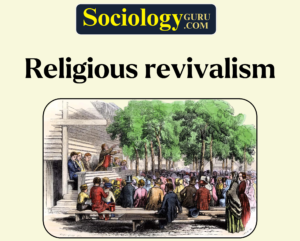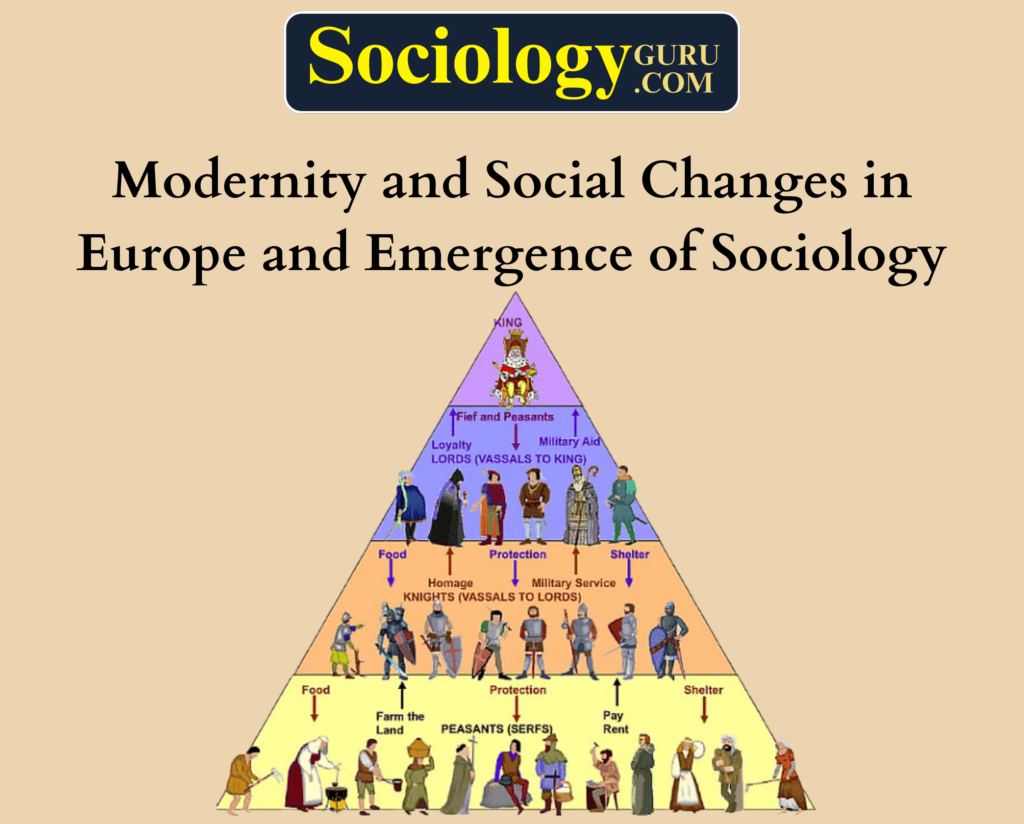Religious revivalism
(Relevant for Sociology optional for UPSC CSE)
Paper-1 ,Unit-8 : Religious revivalism

Religious revivalism is term applied to mass movements which are based upon intense religious upheaval. Periodic religious revivals which seek to restore commitment and attachment to the group are a regular observable feature of religious traditions.
- Revivalism happened in 18th century in western society among methodists. In India Arya samaj is one of the most important revivalist movements which were based on Shuddhi movement. It aimed at converting Hindus back to the fold who had converted to other religions. This had profound impact on Hindu especially lower caste Hindus. They sought to other religions to improve their social status. They also gave equality to women especially in education.
- One view shared by early sociological thinkers was that traditional religion would become more and more marginal to the modern world. Marx, Durkheim and weber all believed that a process of secularization was bound to occur as societies modernized and became more reliant on science and technology to control and explain the social world..
Secularization describes the process whereby religion loses its influence over the various spheres of social life.
- The debate over the secularization thesis is one of the most complex areas in the sociology of religion. In the most basic terms, there is disagreement between supporters of the secularization thesis who agree with sociology’s founding fathers and see religion as diminishing in power and importance in the modern world and opponents of the concept, who argue that religion remains a significant force, albeit often in new and unfamiliar forms.
- The enduring popularity of new religious movements presents a challenge to the secularization thesis. Opponents of the thesis point to the diversity and dynamism of new religious movements and argue that religion and spirituality remains a central facet of modern life.
- As traditional religions lose their hold, religion is not disappearing, but is being channelled in new directions. Not all scholars agree, however. Proponents of the idea of secularization point out that these movements remain peripheral to society as a whole even if they make a profound impact on the lives of their individual followers. New religious movements are fragmented and relatively unorganized; they also suffer from high turnover rates as people are attracted to a movement for some time and then move on to something new. Compared to a serious religious commitment, they argue, participation in a new religious movement appears little more than a hobby lifestyle choice.
- Revivalism of Catholicism in case of America, glorified Hindutva ideology in case of India is emerging as the major challenges to the pluralistic doctrine of modern society. Therefore, Rodney stark rightly points out that religion is not only providing a source for integration. It is instrumental for the social division as well. Taking this viewpoint into consideration one can offer a critic to Cometian argument that in modern society use of science will continue for the decline of religion. In reality religion is a universal force, it appears in different forms in the history of human society differently influencing to political, social & cultural life of man in a multidimensional manner.
- In contemporary context the rise of religious consciousness or the growth of religious revivalism is offering a major challenge to the pluralistic secular & egalitarian character of the civil society.
Causes of Religious Revivalism:
- New insecurities and alienation that arise out of migration and urbanisation in a globalised world are driving more people to religion as a way of establishing their identities and validating their experiences
- There is a revival of institutional religions across the world. In different parts of the world religion has become more visible, both in its institutional form and as an assertion of identity. This increasing prominence of religion and new forms of religious formations can be located in the social psychology of communities and people who are undergoing socio-economic and cultural transitions.
- One of these transitions is the unprecedented migration of communities and the increasing perception that there is socio-cultural and economic inequality across the world. There is an increasing sense of multiple layers and a process of alienation emerging out of multiple levels of ‘dislocations’ of the self, community and identity. The increasing trends of urbanisation, of migrations within and beyond country borders, consumerism and the aggressive construction of images in the context of globalisation of the media, have created a new sense of individual and collective insecurity and alienation.
- However, the relative visibility of institutional religion may be due also to the increasing role of the ‘image’ industry, rather than true conversion or transformation of people from one faith to another. Religion has many manifestations and we often tend to confuse institutionalised religion with other aspects of religion (personal experience, belief, theology etc).
- The revival of institutionalised religion is partly due to the high visibility it has gained in the media explosion of the last ten years. As institutionalised religions are historically strong in terms of institutionalised resources (money, network, people, structures etc) they can make greater use of the new media, particularly television, to acquire more visibility. The number of genuine Christians (in terms of personal experience of a preferred personal faith) might not have increased, but certainly TV marketing of faith has increased manifold. And the new visibility of ‘images’ can create new delusions and illusions of an accentuated religion without the necessary ‘spiritual’ transformation in the lives of people.
- Then there are new insecurities arising out of social, economic and political transitions and the consequent feeling of alienation they engender. For example, there is enough evidence that those who belong to migrant communities tend to be more religious. The reasons could be partly sociological and cultural. The same way I feel happy to meet an Indian or South Asian in Oslo, a Sudanese would like to meet fellow Sudanese. The nodal points of such an identity network often tend to be religious venues. So, Tamil people residing abroad may come to know each other in a temple, Bangladeshis in a Bengali mosque etc. This is to do with relative marginalisation (in terms of space, cultural comfort zone etc) of migrant communities.
- There are also economic and social insecurities that arise out of the tension of losing a job or being alone in a multicultural environment. These too add to the quest for a ‘sense of belonging’, and ‘identity’ gets accentuated when one feels marginalised in a given context. So many of the first generation of Malayali migrants often feel more strongly about ‘being a Malayali’ than those who live in Kerala. Hence the proliferation of Malayali organisations in the Gulf countries and elsewhere (and many literary awards and Malayalam blogs etc). This also often takes a religious/denominational (caste, creed etc) dimension among newly urbanised or migrant communities.
- There is a new sense of alienation due to increased ‘individuation’, and the consequent feeling of being lonely and insecure. This has an age-related dimension — when one is too young (increased anxiety about jobs) and when one is into middle age (the fear of losing a job, falling sick etc).
- This sense of insecurity has something to do with the new consumerism and globalisation of the economy, where expectations about oneself (as a consumer who would like to ‘possess’ certain comforts) and the consequent insecurity that emanates from the new ‘hire and fire’ culture of globalisation creates new insecurity. So here too one often finds more young people and those who cross middle age tending to seek solace in new spiritual markets of various sorts — from Deepak Chopra to the tele-marketing of pop-gurus of various sorts.
- In the case of countries and communities where there is a social disintegration of erstwhile collective institutional structures (eg tribal communities in Africa, or joint families, or the old neighbourhood parish or temple) there is scope for new network-based identity formation. It is in such a space that networked religion and cell-churches grew exponentially. This process of social disintegration of erstwhile structures and the process of ‘collective spaces of sharing’ also happened due to the unprecedented trend of urbanisation and the movement/migration of people across countries and the world. So the shifts from joint families to post-nuclear families and tribal collectivism also created new forms of individuation and multiple forms of dislocation and resultant alienation.
- It is in this context that institutionalised religions get transformed into ‘spiritual’ or ‘solace’ or ‘feel-good’ modules of customised products in the spiritual marketplace. This network mode of marketing helps to get consumers hooked on psycho-pills of well-packaged and customisedreligion of various sorts. In the context of Christianity, the Charismatic movement and its network forms ‘customised’, ‘personalised’ and ‘flexible’ modules of packaged and commodified ‘spiritualism’ which is lapped up by a new market of relatively more ‘lonely’ and insecure people. That is one of the reasons why prosperity gospel is doing so well in relatively poor African communities in Africa as well as America. Prosperity gospels and ‘healing’ ministries and ‘miracle’ crusades all work on the new insecurities among people and communities who are in a state of transition.
- We are in the midst of an unprecedented transition in the history of the world and in terms of sociological and cultural shifts. In such phases of transition insecurities and alienation take on new forms — social, economic and political. This also creates a new sense of inequality. At an individual level, the most convenient thing is to find one’s own sense of ‘belonging’ by identifying with communities who have a shared sense of belonging. Such belonging can be based on colour, creed or religion. The biggest and oldest institutionalised structure of belonging happens to be institutionalised religion. Adapted to the new technology, media, and globalised network, institutionalised religion thus ‘services’ its new ‘clients’ by using the same old pill but with new modes of delivery.
- Then there is also a new sense of political insecurity that emanates from ‘accentuated identities’ (majority and minority) that create a sense of insecurity (for example when young Australians find it difficult to find jobs, they may feel that Indians are stealing their jobs and then Indians begin to mobilise on the basis of being Indians).
- Such accentuated identities often become defensive in the minority context. So, a young Muslim in Europe or UK may feel more ‘Muslim’ than the Muslim in Dubai. Christians in Europe may feel ‘less Christian’ than the Christians in India or China. The ongoing war in Afghanistan and Iraq, or the new political tensions with Iran or North Korea, are all a residual accentuation of the post-cold war period of the new geo-politics. And here, too, recent history is replayed in multiple forms of colonialism and imperialism.
- Post-cold war politics moved from ‘ideological’ war to ‘identity’-based contestations in many cases. The political economy of such identities gets accentuated among migrant communities. When identity, in its soft or hard form, tends to be the sub-text of macro and micro politics, ordinary people often fall back on the most convenient and accessible network of identity. So there is an increasing assertion of ‘Muslim’ identity even among those Muslims who have a rather moderate or liberal approach to religion. There is an assertion of ‘Hindu’ identity where Hindus are in a minority. Such assertions of identity are often cultural defence mechanisms that emanate from social and cultural insecurities and a sense of alienation.

